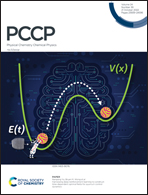Valence-shell ionization of acetyl cyanide: simulation of the photoelectron and infra-red spectra†
Abstract
The vibrational envelopes of the first and second lines of the acetyl cyanide valence photoelectron spectrum [Katsumata et al., J. Electron Spectrosc. Relat. Phenom., 2000, 49, 113] in the gas phase have been simulated considering the Taylor expansion of the dipole moment from zero up to the second order as well as the changes of geometries/frequencies/normal modes between the initial neutral electronic ground state and the final (15a′(−1), 3a′′(−1)) cationic states. It is shown that the vibrational profile of the first band (A′) extending over 3500 cm−1 with a vibrational spacing of 500 cm−1 is not due solely to the overtones (v = 0 → v′ = 1, 2, 3,…) of the C–C![[double bond, length as m-dash]](https://www.rsc.org/images/entities/char_e001.gif) O bending mode as previously suggested but results from a collection of (v = 0 → v′ = 1) transitions with frequencies multiple of 500 cm−1 associated with the C
O bending mode as previously suggested but results from a collection of (v = 0 → v′ = 1) transitions with frequencies multiple of 500 cm−1 associated with the C![[double bond, length as m-dash]](https://www.rsc.org/images/entities/char_e001.gif) O stretching at 1550 cm−1, C–C stretching at 1045 cm−1 and C–C
O stretching at 1550 cm−1, C–C stretching at 1045 cm−1 and C–C![[double bond, length as m-dash]](https://www.rsc.org/images/entities/char_e001.gif) O, C–C
O, C–C![[triple bond, length as m-dash]](https://www.rsc.org/images/entities/char_e002.gif) N bending modes at 370/500 cm−1 completed by combination bands. Our calculations also reveal that the structureless and asymmetric shape of the second band (A′′) is due to the activation of the torsion mode at low-frequency (ω ≈ 150 cm−1) induced by the rotation (60 degrees) of the methyl group blurring the main vibrational progression (ω ≈ 1115 cm−1) corresponding to the cooperative motions of the methyl CH bending and C–C
N bending modes at 370/500 cm−1 completed by combination bands. Our calculations also reveal that the structureless and asymmetric shape of the second band (A′′) is due to the activation of the torsion mode at low-frequency (ω ≈ 150 cm−1) induced by the rotation (60 degrees) of the methyl group blurring the main vibrational progression (ω ≈ 1115 cm−1) corresponding to the cooperative motions of the methyl CH bending and C–C![[double bond, length as m-dash]](https://www.rsc.org/images/entities/char_e001.gif) O bending/C
O bending/C![[double bond, length as m-dash]](https://www.rsc.org/images/entities/char_e001.gif) O stretching. Infra-red spectra of the fundamental and both the 15a′(−1) and 3a′′(−1) cationic states were finally simulated. In contrast to the photoemission spectra, the infrared intensity of the CO stretching motion is very weak. The spectra are mainly dominated by the v = 0 → v = 1 transition of the C
O stretching. Infra-red spectra of the fundamental and both the 15a′(−1) and 3a′′(−1) cationic states were finally simulated. In contrast to the photoemission spectra, the infrared intensity of the CO stretching motion is very weak. The spectra are mainly dominated by the v = 0 → v = 1 transition of the C![[triple bond, length as m-dash]](https://www.rsc.org/images/entities/char_e002.gif) N stretching and the CH symmetric bending/stretching modes, providing complementary information between photoemission and infra-red spectroscopies to capture the nature of the cationic states in acetyl-cyanide.
N stretching and the CH symmetric bending/stretching modes, providing complementary information between photoemission and infra-red spectroscopies to capture the nature of the cationic states in acetyl-cyanide.



 Please wait while we load your content...
Please wait while we load your content...